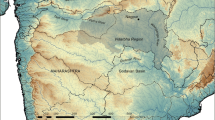Abstract
For decades, archaeologists have looked for an appropriate means to integrate archaeological findings with the textual record. Often, in the past, the written word has been privileged over material remains. In this summary, which draws in part from the individual papers in this special issue, a new, more balanced approach that gives increased weight and greater independence to archaeological data is proposed. A series of implications and suggestions for current theoretical development in archaeology are advanced.
Similar content being viewed by others
References Cited
Bernardini, W. (1996). Transitions in social organization: A predictive model from Southwestern archaeology.Journal of Anthropological Archaeology 15: 372–402.
Binford, L. R. (1972).An Archaeological Perspective, Seminar Press, New York.
Binford, S. R., and Binford, L. R. (eds.) (1968).New Perspectives in Archeology, Aldine, Chicago.
Brandt, E. A. (1994). Egalitarianism, hierarchy, and centralization in the pueblos. In Wills, W. H., and Leonard, R. D. (eds.),The Ancient Southwestern Community: Models and Methods for the Study of Prehistoric Social Organization, University of New Mexico Press, Albuquerque, pp. 9–23.
Braudel, F. (1972).The Mediterranean and the Mediterranean World in the Age of Philip II. 2 vols. (S. Reynolds, trans.), Harper and Row, New York.
Champion, T. (1990). Medieval archaeology and the tyranny of the historical record. In Austin, D., and Alcock, L. (eds.),From the Baltic to the Black Sea, Studies in Medieval Archaeology, Unwin Hyman, London, pp. 79–95.
Diamond, J. (1996). Empire of uniformity.Discover 17: 78–85.
Falkenhausen, L. von. (1993). On the historiographical orientation of Chinese archaeology.Antiquity 67: 839–849.
Feinman, G. M. (1994) Toward an archaeology without polarization: Comments on contemporary theory. In Marcus, J. and Zeitlin, J. F. (eds.),Caciques and Their People: A Volume in Honor of Ronald Spores, Anthropological Papers, No. 89, Museum of Anthropology, University of Michigan, Ann Arbor, pp. 13–43.
Flannery, K. V. (ed.), (1976).The Early Mesoamerican Village, Academic Press, New York.
Gould, S. J. (1987).An Urchin in the Storm: Essays About Books and Ideas, W. W. Norton, New York.
Hodder, I. (1986).Reading the Past: Current Approaches to Interpretation in Archaeology, Cambridge University Press, Cambridge.
Kluckhohn, C. (1940). The conceptual structure in Middle American studies. In Hay, C. L., Linton, R. L., Lothrop, S. K., Shapiro, H. L., and Vaillant, G. C. (eds.),The Maya and Their Neighbors, Appleton-Century, New York, pp. 41–51.
Knapp, A. B. (ed.) (1992).Archaeology, Annales, and Ethnohistory, Cambridge University Press, Cambridge.
Kroeber, A. L. (1935). History and science in anthropology.American Anthropologist 35: 539–569.
Larson, D. O., Neff, H., Graybill, D. A., Michaelsen, J., and Ambos, E. (1996). Risk, climatic variability, and the study of Southwestern prehistory: An evolutionary approach.American Antiquity 61: 217–241.
Leonard, R. D., and Reed, H. E. (1993). Population aggregation in the prehistoric American Southwest: A selectionist model.American Antiquity 58: 648–661.
Levy, J. E. (1994). Ethnographic analogs: Strategies for reconstructing archaeological cultures. In Gumerman, G. J., and Gell-Mann, M. (eds.),Understanding Complexity in the Prehistoric Southwest, Addison-Wesley, Reading, MA, pp. 233–244.
Lightfoot, K. G., (1995). Culture contact studies: Redefining the relationship between prehistoric and historical archaeology.American Antiquity 60: 199–217.
Lightfoot, K. G., and Upham, S. (1989). Complex societies in the prehistoric American Southwest: A consideration of the controversy. In Upham, S., Lightfoot, K. G., and Jewett, R. A. (eds.),The Sociopolitical Structure of Prehistoric Southwestern Societies, Westview Press, Boulder, CO, pp. 3–30.
McGuire, R. H., and Saitta, D. J. (1996). Although they have petty captains, they obey them badly: The dialectics of prehispanic western Pueblo social organization.American Antiquity 61: 197–216.
Olsen, J. W. (1987) The practice of archaeology in China today.Antiquity 61: 282–290.
Plog, F. (1974).The Study of Prehistoric Change, Academic Press, New York.
Plog, S. (1995). Equality and hierarchy: Holistic approaches to understanding social dynamics in the Pueblo Southwest. In Price, T. D., and Feinman, G. M. (eds.),Foundations of Social Inequality, Plenum Press, New York, pp. 189–206.
Renfrew, C., and Bahn, P. (1996).Archaeology: Theories, Methods, and Practice, 2nd ed., Thames and Hudson, London.
Rudolph, S. H. (1987). Presidential address: State formation in Asia—Prolegmenon to a comparative study.The Journal of Asian Studies 46: 731–746.
Schiffer, M. B. (1990). Review ofArchaeology as Long-term History.American Antiquity 55: 423–424.
Shanks, M., and Tilley, C. (1987).Re-constructing Archaeology: Theory and Practice, Cambridge University Press, Cambridge.
Smith, M. E. (1992). Rhythms of change in postclassic central Mexico: Archaeology, ethnohistory, and Braudelian model. In Knapp, A. B. (ed.),Archaeology, Annales, and Ethnohistory, Cambridge, University Press, Cambridge, pp. 51–74.
Stahl, A. B. (1993). Concepts of time and approaches to analogical reasoning in historical perspective.American Antiquity 58: 235–260.
Taylor, W. W. (1964).A Study of Archeology, Southern Illinois University Press, Carbondale (originally published 1948).
Trigger, B. G. (1984). Alternative archaeologies: Nationalist, colonialist, imperialist.Man 19: 355–370.
Trigger, B. G. (1989).A History of Archaeological Thought, Cambridge University Press, Cambridge.
Upham, S. (1987). The tyranny of ethnographic analogy in Southwestern archaeology. In Gaines, S. W. (ed.),Coasts, Plains, and Deserts: Essays in Honor of Reynold J. Ruppé, Anthropological Research Papers, No. 38, Arizona State University, Tempe, pp. 265–279.
Whiteley, P. M. (1988).Deliberate Acts: Changing Hopi Culture Through the Oraibi Split, University of Arizona Press, Tucson.
Willey, G. R., and Sabloff, J. A. (1993).A History of American Archaeology, 3rd ed, W. H. Freeman, New York.
Wills, W. H., and Leonard, R. D. (eds.) (1994).The Ancient Southwestern Community: Models and Methods for the Study of Prehistoric Social Organization, University of New Mexico Press, Albuquerque.
Wobst, H. M. (1978). The archaeo-ethnology of hunter-gatherers or the tyranny of the ethnographic record in archaeology.American Antiquity 43: 303–309.
Author information
Authors and Affiliations
Rights and permissions
About this article
Cite this article
Feinman, G.M. Thoughts on new approaches to combining the archaeological and historical records. J Archaeol Method Theory 4, 367–377 (1997). https://doi.org/10.1007/BF02428069
Issue Date:
DOI: https://doi.org/10.1007/BF02428069




